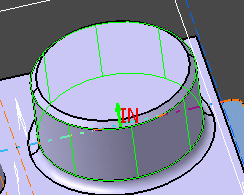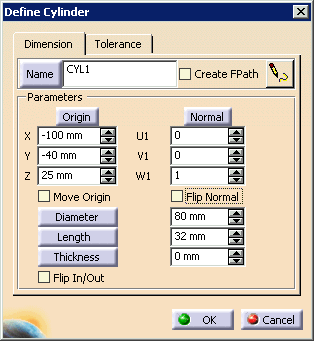 |
This procedure describes how to define a
cylinder feature. A cylinder feature will appear as an activity of
the process on the PPR tree. |
 |
To define a cylinder feature, you must have
a product loaded. |
 |
-
Select the parent process or preceding activity for
the define cylinder activity.
-
On the Inspection Activities toolbar, click
Define Cylinder
 . .
| The Define Cylinder dialog box appears. |
 |
 |
When you first create a feature, you need to select a
thickness for it. Inspect uses that thickness value as the
default value thereafter. |
 |
See also Using Bounds. |
-
On the 3D geometry, select the cylinder.
| Once selected, the cylinder is highlighted and a
green arrow, signifying normal, protrudes from it. The
in/out direction of the feature is specified in red. Either
or both can be flipped by checking boxes on the dialog box. |
 |
| You may enter a name for the cylinder in the name
frame. |
| The Define Cylinder dialog box also contains the
data for the cylinder selected. |
 |
 |
For an image defining the dimensions, click on the button. The image appears.
The image appears. |
| |
 |
| |
You can alter the cylinder's circle definition by clicking on
the Diameter button, and then selecting three points on
the geometry with which to redefine the circle. |
| |
You can also alter the direction of Origin, Normal, Length,
and Thickness by selecting the buttons with those parameter names. |
| |
If you select any of these buttons, the dialog box disappears,
and the appropriate toolbox appears in its place. Select the
button on the toolbar that changes the direction as desired. |
| |


 |
 |
See About the Toolboxes for
information on using the toolboxes. |
-
Select on the OK button.
| The activity is added to the PPR tree: |
| The defined cylinder appears highlighted on the part geometry: |
 |
|
 |
If you check the FPath box, you
can measure the feature at the same time you create it. |
| |
Checking Flip In/Out controls
how the measurement path is set relative to the feature. When the
option is checked, the measurement path follows the outside of the
feature; when it is not checked, the path keeps the probe inside the
feature. |
| |
Selecting Move Origin alters
origin point of the measurement path. |







